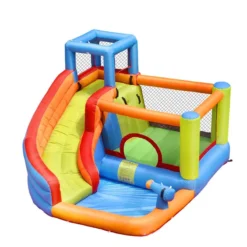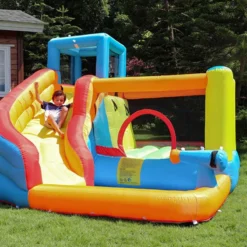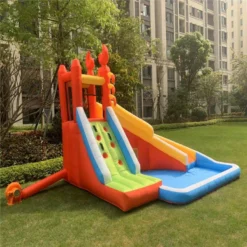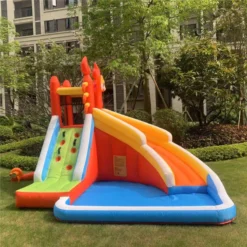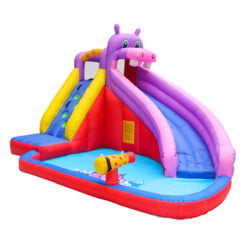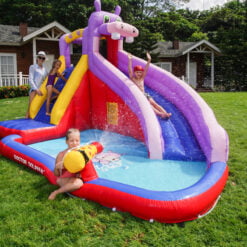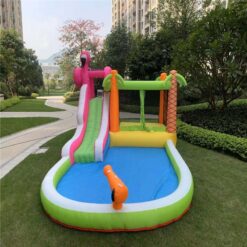تعتبر المنازل المرتدة طريقة رائعة لإضفاء الحياة والإثارة على أي حدث، سواء كان حفل عيد ميلاد، أو تجمع عائلي، أو حدث مجتمعي. عند شراء منزل مرتد، من الضروري فهم المواد المختلفة المتاحة وخصائصها الفريدة. القماش المشمع PVC والفينيل ونسيج أكسفورد هي مواد شائعة الاستخدام في الصناعة. في هذه المقالة، سنتعمق في الاختلافات بين هذه المواد، وإيجابياتها وسلبياتها، وبعض الأسئلة الشائعة لمساعدتك على اتخاذ قرار مستنير.
ما هو القماش المشمع PVC؟
القماش المشمع PVC، والذي يشار إليه غالبًا باسم قماش القنب PVC أو قماش الفينيل، هو مادة بلاستيكية قوية ومرنة ومقاومة للماء. لقد تم تصنيعها من خلال الجمع بين أفلام PVC والنسيج الأساسي من البوليستر، مما يخلق مادة متعددة الاستخدامات مثالية لمختلف التطبيقات.
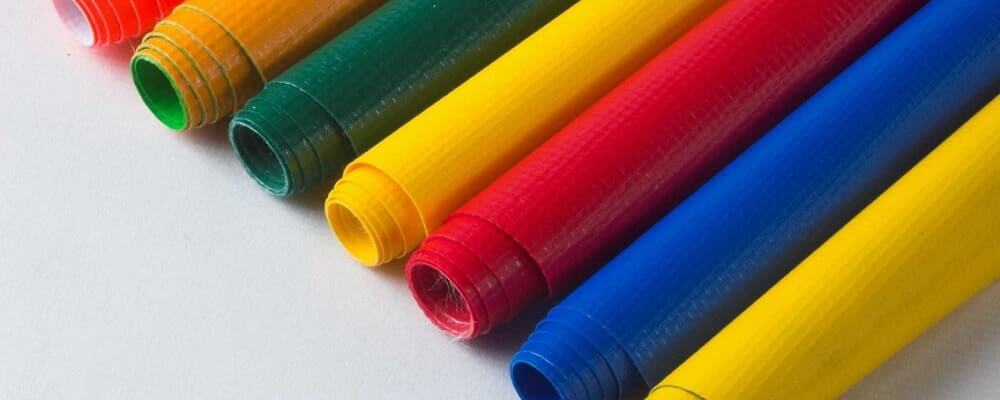
هناك ثلاثة أنواع رئيسية من هياكل القماش المشمع PVC: طبقتان، ثلاث طبقات، وأربع طبقات. يتكون الهيكل المكون من طبقتين من طبقة فيلم PVC واحدة وطبقة قماش أساسية مصنوعة من مواد مثل البوليستر أو القطن أو النايلون أو الألياف الزجاجية أو مزيج منها. وفي الوقت نفسه، يتميز الهيكل ذو الثلاث طبقات بطبقتين من أفلام PVC مع وضع القماش الأساسي بينهما. يضيف الهيكل المكون من 4 طبقات طبقة سوداء إلى الهيكل المكون من 3 طبقات، ويتم وضعها بين طبقتين من طبقة PVC، مما يوفر متانة وقوة إضافية.
| أنواع | صورة | بناء | عنصر | طلب |
|---|---|---|---|---|
| اقتصادية |  | 2 طبقة | 1. فيلم كلوريد البوليفينيل 2. النسيج الأساسي | أكياس، الحصير الصالة الرياضية |
| موسيقى البوب | 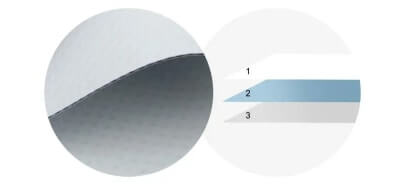 | 3 طبقة | 1. فيلم كلوريد البوليفينيل 2. النسيج الأساسي 3. فيلم كلوريد البوليفينيل | لافتات، الأقمشة، ويغطي |
| غالي | 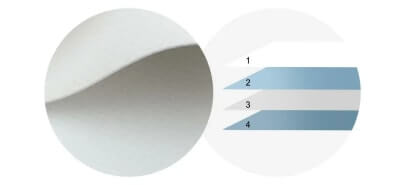 | 4 طبقة | 1. فيلم كلوريد البوليفينيل 2. طبقة سوداء 3. النسيج الأساسي 4. فيلم PVC | لافتات، خيمة (ضوء حجب) |
النوع الأكثر استخدامًا من القماش المشمع PVC للمنازل المرتدة هو الهيكل المكون من ثلاث طبقات. ستجد عادةً سماكة من القماش المشمع PVC تتراوح من 0.4 مم إلى 0.6 مم (15 إلى 22 أونصة/يارد²) وأوزان تتراوح بين 450 إلى 610 جرامًا للمتر المربع. يعتمد اختيار السُمك والوزن على عوامل مثل التطبيق المقصود والمتانة المطلوبة وسهولة التعامل.
يوفر القماش المشمع PVC الأكثر سمكًا وأثقل متانة أفضل ومقاومة للثقب، مما يجعله مثاليًا للمنازل التجارية أو التطبيقات الثقيلة. يمكن لهذا النوع من القماش المشمع أن يتحمل الاستخدام المتكرر ويوفر بنية أكثر قوة.
من ناحية أخرى، قد يكون القماش المشمع PVC الأرق والأخف وزنًا أكثر ملاءمة للمنازل السكنية أو المطاطية المستخدمة في بعض الأحيان. على الرغم من أنها خفيفة الوزن وأسهل في التعامل معها، إلا أنها قد لا تكون متينة مثل نظيرتها الأكثر سمكًا. عند اختيار القماش المشمع PVC المناسب لمنزلك المرتد، ضع في اعتبارك المتانة المطلوبة وسهولة التعامل للعثور على التوازن المثالي.
الايجابيات:
- متين للغاية ومقاوم للتآكل
- مقاومة للماء، مما يجعلها مناسبة للبيئات الرطبة
- سهلة التنظيف والصيانة
سلبيات:
- أثقل من قماش أكسفورد
- أقل تنفساً، مما قد يؤدي إلى ارتفاع درجات الحرارة داخل المنزل المرتد
ما هو نسيج أكسفورد؟
نسيج أكسفورد هو مادة خفيفة الوزن وجيدة التهوية مصنوعة من البوليستر المنسوج. إنه بديل فعال من حيث التكلفة لمشمع PVC والفينيل، مما يوفر متانة ممتازة ومقاومة للتآكل.
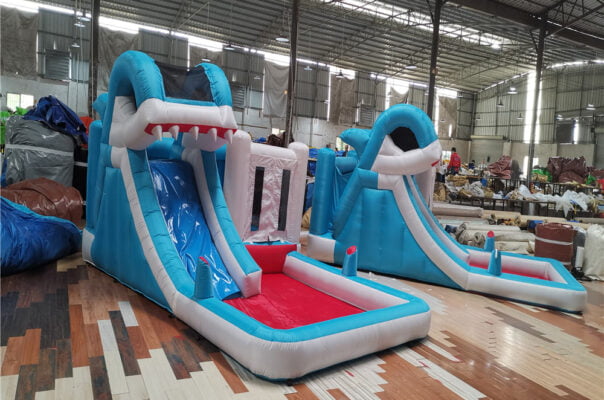
هناك درجات مختلفة من قماش أكسفورد تختلف في السمك والوزن وعدد الدنير، والذي يشير إلى سمك خيوط القماش. يشير عدد الدنير، الذي يتم تمثيله عادةً بالحرف "D"، إلى وزن القماش وسمكه. يؤدي ارتفاع عدد الدنير إلى الحصول على أقمشة أكثر سمكًا وأكثر متانة.
بالنسبة للبيوت المرتدة، يتراوح نسيج أكسفورد عادةً من 210D إلى 1680D. فيما يلي بعض أعداد المنكرين الشائعة وخصائصها المقابلة:
- 210 د: خفيفة الوزن، وأرق، ومناسبة للمنازل السكنية أو المطاطية المستخدمة في بعض الأحيان. يوفر متانة أقل ولكنه أسهل في التعامل والنقل.
- 420 د: متوسط الوزن، مما يوفر التوازن بين المتانة وسهولة التعامل. مناسبة للاستخدام السكني وبعض التطبيقات التجارية.
- 600 د: أثقل وأكثر سمكًا، مما يوفر متانة أكبر ومقاومة للتآكل. يشيع استخدامها في المنازل التجارية والمطاطية.
- 1000 د-1680 د: نسيج أكسفورد الأثقل والأسمك، مثالي للمنازل التجارية شديدة التحمل أو المطاطية التي تتطلب متانة وقوة استثنائية.
الايجابيات:
- خفيفة الوزن وسهلة النقل
- مسامي، مما يجعله مناسبًا للبيئات الحارة أو الجافة
- أكثر بأسعار معقولة من القماش المشمع PVC والفينيل
سلبيات:
- أقل مقاومة للماء من القماش المشمع PVC والفينيل
- قد لا تكون متينة في الظروف القاسية
جدول المقارنة للقماش المشمع PVC ونسيج أكسفورد
| ميزة | القماش المشمع PVC | قماش أكسفورد |
|---|---|---|
| تكوين المواد | أفلام PVC والنسيج الأساسي من البوليستر | ألياف البوليستر المنسوجة مع طلاء |
| سمك مشترك | 0.4 ملم - 1.2 ملم | 210D - 1680D (عدد المنكرين) |
| متانة | متينة للغاية، ومقاومة للتمزق | متين ومقاوم للتآكل |
| مقاومة الماء | ضد للماء | مقاومة للماء للماء |
| مقاومة الحريق | مقاومة للحريق مع مثبطات الحريق | مقاومة للحريق مع مثبطات الحريق |
| وزن | أثقل | أخف وزنا |
| صيانة & تنظيف | سهلة التنظيف والصيانة | سهلة التنظيف والصيانة |
| يكلف | عموما أكثر تكلفة | أكثر بأسعار معقولة |
| التطبيقات المشتركة | المنازل التجارية والثقيلة ترتد | الاستخدام السكني والتجاري الخفيف |
يقدم هذا الجدول مقارنة بين القماش المشمع PVC ونسيج أكسفورد، وهما مادتان شائعتان تستخدمان في بناء المنازل المرتدة. يوضح الجدول الاختلافات في التركيب والسمك والمتانة ومقاومة الماء ومقاومة الحريق والوزن والصيانة والتكلفة والتطبيقات الشائعة لكلا المادتين.
الأسئلة الشائعة
س1: هل أقمشة PVC والفينيل وأكسفورد آمنة للأطفال؟
نعم، تم تصميم أقمشة PVC والفينيل وأكسفورد المستخدمة في المنازل النطاطة القابلة للنفخ لتكون آمنة للأطفال. يأخذ المصنعون السلامة في الاعتبار عند إنتاج المطاطية وغالبًا ما يستخدمون مواد خالية من الرصاص والفثالات تلبي معايير السلامة الصناعية.
س 2: ما هي الاختلافات بين القماش المشمع PVC والفينيل وبيوت أكسفورد القماشية؟
يعتبر القماش المشمع PVC والفينيل من المواد المتينة والمقاومة للماء، في حين أن قماش أكسفورد هو خيار أخف وزنًا وأكثر مسامية. كل مادة لها مزاياها وعيوبها، لذا ضع في اعتبارك عوامل مثل المناخ وأنماط الاستخدام والميزانية عند اختيار المادة المناسبة لمنزلك المرتد.
س 3: كيف يمكنني الحفاظ على منزل مرتد مصنوع من القماش المشمع PVC أو الفينيل أو قماش أكسفورد؟
يعد التنظيف والصيانة المنتظمة أمرًا ضروريًا للحفاظ على منزلك المرتد في حالة رائعة، بغض النظر عن المواد المستخدمة. اتبع هذه الخطوات للحصول على الرعاية المناسبة:
- الاجتياح والفراغ: قم بإزالة أي حطام أو أوساخ عن طريق مسح سطح المنزل المرتد وتنظيفه بالمكنسة الكهربائية.
- يُنظف بصابون خفيف وماء: استخدمي محلولًا خفيفًا من الصابون والماء لتنظيف السطح بلطف. تجنب استخدام المواد الكيميائية القاسية أو الأدوات الكاشطة التي قد تلحق الضرر بالمادة.
- شطف جيدا: اشطف المنزل المرتد بالماء النظيف لإزالة أي بقايا صابون.
- يجف تماما: اترك المنزل المرتد يجف تمامًا في الهواء قبل طيه أو تخزينه. وهذا يساعد على منع نمو العفن والعفن.
- فحص وإصلاح: قم بفحص منزلك المرتد بانتظام بحثًا عن أي علامات تآكل أو تلف. قم بإصلاح الثقوب الصغيرة أو التمزقات باستخدام مجموعة إصلاح مصممة خصيصًا للمادة القابلة للنفخ.

